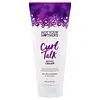What's inside
What's inside
 Benefits
Benefits

No benefits
 Concerns
Concerns

 Ingredients Side-by-side
Ingredients Side-by-side

Water
Skin ConditioningPolyacrylamide
C13-14 Isoparaffin
EmollientShea Butter Ethyl Esters
EmollientPolyquaternium-10
Lactobacillus/Tomato Fruit Ferment Extract
Skin ConditioningOryza Sativa Extract
AbsorbentKeratin Amino Acids
Skin ConditioningLeuconostoc/Radish Root Ferment Filtrate
AntimicrobialAcyl Coenzyme A Desaturase
Skin ConditioningLaureth-7
EmulsifyingPg-Hydroxyethylcellulose Cocodimonium Chloride
Parfum
MaskingDisodium EDTA
Phenoxyethanol
PreservativeEthylhexylglycerin
Skin ConditioningWater, Polyacrylamide, C13-14 Isoparaffin, Shea Butter Ethyl Esters, Polyquaternium-10, Lactobacillus/Tomato Fruit Ferment Extract, Oryza Sativa Extract, Keratin Amino Acids, Leuconostoc/Radish Root Ferment Filtrate, Acyl Coenzyme A Desaturase, Laureth-7, Pg-Hydroxyethylcellulose Cocodimonium Chloride, Parfum, Disodium EDTA, Phenoxyethanol, Ethylhexylglycerin
Ingredients Explained
These ingredients are found in both products.
Ingredients higher up in an ingredient list are typically present in a larger amount.
This ingredient is also known as "C13-14 Isoalkane".
C13-14 Isoparaffin is created from petroleum-based mineral oils. It is an emollient and helps thicken a product.
As an emollient, it helps keep the skin soft and smooth by creating a barrier on top. This barrier traps moisture in, keeping the skin hydrated.
C13-14 Isoparaffin may not be fungal-acne safe.
Learn more about C13-14 IsoparaffinEthylhexylglycerin (we can't pronounce this either) is commonly used as a preservative and skin softener. It is derived from glyceryl.
You might see Ethylhexylglycerin often paired with other preservatives such as phenoxyethanol. Ethylhexylglycerin has been found to increase the effectiveness of these other preservatives.
Laureth-7 is created by the ethoxylation of lauryl alcohol using ethylene oxide. Lauryl alcohol is a fatty alcohol with hydrating properties.
This ingredient is an emulsifier and cleansing ingredient. As an emulsifier, it is used to prevent ingredients from separating. It also helps cleanse the skin by gathering dirt, oil, and pollutants to be rinsed away.
We don't have a description for Pg-Hydroxyethylcellulose Cocodimonium Chloride yet.
Phenoxyethanol is a preservative that has germicide, antimicrobial, and aromatic properties. Studies show that phenoxyethanol can prevent microbial growth. By itself, it has a scent that is similar to that of a rose.
It's often used in formulations along with Caprylyl Glycol to preserve the shelf life of products.
Polyacrylamide is a synthetic polymer. It is used to stabilize products and bind ingredients. When hydrated, Polyacrylamide forms a soft gel.
Polyacrylamide is low-toxicity. If source properly, it is deemed safe to use in cosmetics.
It should be noted the precursor to Polyacrylamide is acrylamide. Acrylamide is a carcinogen. Most reputable sources of Polyacrylamide will screen for residual acrylamide to make sure the count is in a safe range. Acrylamide is not able to be absorbed through the skin.
We recommend speaking with a professional if you have concerns.
Learn more about PolyacrylamidePolyquaternium-10 is an ammonium salt of hydroxyethylcellulose. It is a white and granular powder used as a film-former and anti-static agent.
This ingredient is commonly found in hair conditioning products. According to a manufacturer, its positive charge makes it great for absorbing hair proteins. The manufacturer also states this ingredient helps with curl retention.
For haircare friends: this ingredient is not a silicone.
Learn more about Polyquaternium-10Water. It's the most common cosmetic ingredient of all. You'll usually see it at the top of ingredient lists, meaning that it makes up the largest part of the product.
So why is it so popular? Water most often acts as a solvent - this means that it helps dissolve other ingredients into the formulation.
You'll also recognize water as that liquid we all need to stay alive. If you see this, drink a glass of water. Stay hydrated!
Learn more about Water